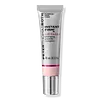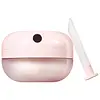What's inside
What's inside
 Key Ingredients
Key Ingredients

 Benefits
Benefits

 Concerns
Concerns

 Ingredients Side-by-side
Ingredients Side-by-side

Polyisobutene
Squalane
EmollientC12-15 Alkyl Benzoate
AntimicrobialHydrogenated Polydecene
EmollientOctyldodecanol
EmollientHelianthus Annuus Seed Wax
Skin ConditioningSimmondsia Chinensis Seed Oil
EmollientVinyl Dimethicone/Lauryl Dimethicone Crosspolymer
Theobroma Cacao Seed Butter
EmollientTribehenin
EmollientEthylhexyl Palmitate
EmollientCocos Nucifera Oil
MaskingSilica
AbrasiveCaprylic/Capric Triglyceride
MaskingPrunus Amygdalus Dulcis Oil
Skin ConditioningPunica Granatum Seed Oil
EmollientButyrospermum Parkii Butter
Skin ConditioningDipalmitoyl Hydroxyproline
Skin ConditioningPalmitoyl Tripeptide-1
Skin ConditioningSesamum Indicum Seed Extract
Skin ConditioningGlucomannan
Skin ConditioningDimethyl Isosorbide
SolventGlyceryl Caprylate
EmollientLinoleic Acid
CleansingTocopheryl Acetate
AntioxidantPalmitic Acid
EmollientMentha Piperita Oil
MaskingTocopherol
AntioxidantSodium Hyaluronate
HumectantCapsicum Frutescens Fruit Extract
Skin ConditioningLinolenic Acid
CleansingTrihydroxystearin
Skin ConditioningSorbitan Isostearate
EmulsifyingCoco-Caprylate/Caprate
EmollientGlyceryl Undecylenate
EmollientPolyhydroxystearic Acid
EmulsifyingPolyglyceryl-6 Polyricinoleate
EmulsifyingDilinoleic Acid/Butanediol Copolymer
Disodium Stearoyl Glutamate
CleansingWater
Skin ConditioningCastor Oil/Ipdi Copolymer
Mica
Cosmetic ColorantTin Oxide
AbrasiveTitanium Dioxide
Cosmetic ColorantIron Oxides
Polyisobutene, Squalane, C12-15 Alkyl Benzoate, Hydrogenated Polydecene, Octyldodecanol, Helianthus Annuus Seed Wax, Simmondsia Chinensis Seed Oil, Vinyl Dimethicone/Lauryl Dimethicone Crosspolymer, Theobroma Cacao Seed Butter, Tribehenin, Ethylhexyl Palmitate, Cocos Nucifera Oil, Silica, Caprylic/Capric Triglyceride, Prunus Amygdalus Dulcis Oil, Punica Granatum Seed Oil, Butyrospermum Parkii Butter, Dipalmitoyl Hydroxyproline, Palmitoyl Tripeptide-1, Sesamum Indicum Seed Extract, Glucomannan, Dimethyl Isosorbide, Glyceryl Caprylate, Linoleic Acid, Tocopheryl Acetate, Palmitic Acid, Mentha Piperita Oil, Tocopherol, Sodium Hyaluronate, Capsicum Frutescens Fruit Extract, Linolenic Acid, Trihydroxystearin, Sorbitan Isostearate, Coco-Caprylate/Caprate, Glyceryl Undecylenate, Polyhydroxystearic Acid, Polyglyceryl-6 Polyricinoleate, Dilinoleic Acid/Butanediol Copolymer, Disodium Stearoyl Glutamate, Water, Castor Oil/Ipdi Copolymer, Mica, Tin Oxide, Titanium Dioxide, Iron Oxides
Diisostearyl Malate
EmollientHydrogenated Polyisobutene
EmollientPhytosteryl/Isostearyl/Cetyl/Stearyl/Behenyl Dimer Dilinoleate
Skin ConditioningPolybutene
Hydrogenated Poly(C6-14 Olefin)
EmollientButyrospermum Parkii Butter
Skin ConditioningMicrocrystalline Wax
Emulsion StabilisingSynthetic Wax
AbrasiveEthylene/Propylene/Styrene Copolymer
Sucrose Tetrastearate Triacetate
EmollientMica
Cosmetic ColorantCI 77891
Cosmetic ColorantEuphorbia Cerifera Wax
Ethylhexyl Palmitate
EmollientParfum
MaskingCandelilla Wax Esters
Astrocaryum Murumuru Seed Butter
EmollientTribehenin
EmollientMenthoxypropanediol
MaskingGlycerin
HumectantCocos Nucifera Oil
MaskingOenothera Biennis Oil
EmollientLecithin
EmollientButylene/Ethylene/Styrene Copolymer
Sorbitan Isostearate
EmulsifyingCopernicia Cerifera Wax
Dehydroacetic Acid
PreservativeAdenosine
Skin ConditioningTocopherol
AntioxidantLactic Acid
BufferingPentaerythrityl Tetra-Di-T-Butyl Hydroxyhydrocinnamate
AntioxidantPalmitoyl Tripeptide-1
Skin ConditioningDiisostearyl Malate, Hydrogenated Polyisobutene, Phytosteryl/Isostearyl/Cetyl/Stearyl/Behenyl Dimer Dilinoleate, Polybutene, Hydrogenated Poly(C6-14 Olefin), Butyrospermum Parkii Butter, Microcrystalline Wax, Synthetic Wax, Ethylene/Propylene/Styrene Copolymer, Sucrose Tetrastearate Triacetate, Mica, CI 77891, Euphorbia Cerifera Wax, Ethylhexyl Palmitate, Parfum, Candelilla Wax Esters, Astrocaryum Murumuru Seed Butter, Tribehenin, Menthoxypropanediol, Glycerin, Cocos Nucifera Oil, Oenothera Biennis Oil, Lecithin, Butylene/Ethylene/Styrene Copolymer, Sorbitan Isostearate, Copernicia Cerifera Wax, Dehydroacetic Acid, Adenosine, Tocopherol, Lactic Acid, Pentaerythrityl Tetra-Di-T-Butyl Hydroxyhydrocinnamate, Palmitoyl Tripeptide-1
 Reviews
Reviews

Ingredients Explained
These ingredients are found in both products.
Ingredients higher up in an ingredient list are typically present in a larger amount.
This ingredient is also known as shea butter. It is an effective skin hydrator and emollient.
Emollients help soothe and soften your skin. It does this by creating a protective film on your skin. This barrier helps trap moisture and keeps your skin hydrated. Emollients may be effective at treating dry or itchy skin.
Shea butter is rich in antioxidants. Antioxidants help fight free-radicals, or molecules that may harm the body. It is also full of fatty acids including stearic acid and linoleic acid. These acids help replenish the skin and keep skin moisturized.
While Shea Butter has an SPF rating of about 3-4, it is not a sunscreen replacement.
Shea butter may not be fungal acne safe. We recommend speaking with a professional if you have any concerns.
Learn more about Butyrospermum Parkii ButterCocos Nucifera Oil is obtained from the kernels of the coconut fruit. In other words, this is coconut oil.
Coconut Oil is rich in fatty acids with lauric acid making up the majority of these. It also contains linoleic acid. Due to this high fatty acid content, coconut oil helps trap moisture and soften skin.
Despite being antibacterial, coconut oil may not be great for acne-prone skin. It is comedogenic and may clog pores. This ingredient may not be safe for malassezia or fungal acne.
Note: Coconut Oil should not replace your sunscreen for UV protection. Studies show it only blocks about 20% of UV.
This oil is non-volatile and has a light scent.
The term 'fragrance' is not regulated in many countries. In many cases, it is up to the brand to define this term. For instance, many brands choose to label themselves as "fragrance-free" because they are not using synthetic fragrances. However, their products may still contain ingredients such as essential oils that are considered a fragrance.
Learn more about Cocos Nucifera OilEthylhexyl Palmitate, also known as octyl palmitate, is created from 2-ethylhexyl alcohol and palmitic acid. It is a fatty acid ester.
The fatty acid content of Ethylhexyl Palmitate makes it an emollient. Emollients help soften and hydrate your skin by trapping moisture within.
Ethylhexyl Palmitate is also used to help improve the texture of cosmetics. It helps other ingredient dissolve in products and help disperse ingredients more evenly.
You'll likely find this ingredient in sunscreen, as it is often used to mix UV-blocking ingredients such as avobenzone and ethylhexyl triazone.
It can also help stabilize the fragrances in a product as a fragrance fixative.
Ethylhexyl Palmitate can be used to substitute mineral oil.
Due to its high fatty acid content, it may not be fungal-acne safe.
Learn more about Ethylhexyl PalmitateMica is a naturally occurring mineral used to add shimmer and color in cosmetics. It can also help improve the texture of a product or give it an opaque, white/silver color.
Serecite is the name for very fine but ragged grains of mica.
This ingredient is often coated with metal oxides like titanium dioxide. Trace amounts of heavy metals may be found in mica, but these metals are not harmful in our personal products.
Mica has been used since prehistoric times throughout the world. Ancient Egyptian, Indian, Greek, Roman, Aztec, and Chinese civilizations have used mica.
Learn more about MicaPalmitoyl Tripeptide-1 is also known as pal-GHK. It is made up of 3 amino acids and palmitic acid, a fatty acid that helps it absorb into skin more easily.
This peptide is as a signal peptide, meaning it tells the skin to produce more collagen. Collagen is the key protein that helps form the skin's structure and keep it plump, firm, and hydrated.
By boosting collagen production, this ingredient supports a stronger skin barrier and helps reduce the appearance of wrinkles.
You'll most likely see this ingredient paired with Palmitoyl Tetrapeptide-7 in the well-known Matrixyl 3000 complex. While results from in-house testing should be viewed cautiously, this peptide duo is among the most studied and widely used in modern skincare.
Due to its palmitic acid base, this ingredient may not be safe for Malassezia folliculitis.
Read more about other common types of peptides here:
Learn more about Palmitoyl Tripeptide-1Sorbitan Isostearate is an emulsifer and cleaning agent. It is created from isostearic acid and sorbitol.
As an emulsifier, Sorbitan Isostearate prevents oils and water from separating.
Due to its isostearic acid base, it may not be safe for Malassezia or fungal acne.
Learn more about Sorbitan IsostearateTocopherol (also known as Vitamin E) is a common antioxidant used to help protect the skin from free-radicals and strengthen the skin barrier. It's also fat soluble - this means our skin is great at absorbing it.
Vitamin E also helps keep your natural skin lipids healthy. Your lipid skin barrier naturally consists of lipids, ceramides, and fatty acids. Vitamin E offers extra protection for your skin’s lipid barrier, keeping your skin healthy and nourished.
Another benefit is a bit of UV protection. Vitamin E helps reduce the damage caused by UVB rays. (It should not replace your sunscreen). Combining it with Vitamin C can decrease sunburned cells and hyperpigmentation after UV exposure.
You might have noticed Vitamin E + C often paired together. This is because it is great at stabilizing Vitamin C. Using the two together helps increase the effectiveness of both ingredients.
There are often claims that Vitamin E can reduce/prevent scarring, but these claims haven't been confirmed by scientific research.
Learn more about TocopherolTribehenin comes from glycerin and behenic acid.
It is used as an emollient, or moisturizer. Emollients form a thin barrier on skin to prevent moisture from escaping.
This ingredient may not be Malassezia folliculitis, or fungal-acne safe.
Learn more about Tribehenin